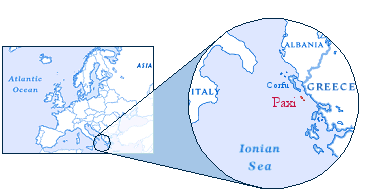
Christoph Buondelmonti reports that in 1824, Paxoi were a part of Corfu, but due to the frequent tempests caused by Poseidon and Aeolus, Paxoi were separated from Corfu. So, Paxoi, the smallest of the Ionian Islands, are located south of Corfu, at a distance of 7 miles and opposite the coasts of Epirus, at a distance of 12 miles from Parga.

Paxoi are a complex of islands and rocks. The most important ones are Paxoi, Antipaxoi, Mongonissi, Kaltsionissi, Ai Nikolas, Panayia, Daskalia etc. The shape of Paxoi is elongate making it look like a lizard and so does Antipaxoi. These two islands cover a surface of 19 sq. km and 3 sq. km respectively. Paxoi is a vast olive-orchard and Antipaxoi a large vineyard. The ground is elevated, forming hills and the soil is calciferous. Due to the composition of the subsoil, no subterranean water can be contained. The east coasts are smooth whereas the west ones are steep, with considerable geological formations: caves, vaults, vertical precipices etc.
There are many sulphurous springs and in some areas asphalt spouts from the ground. In the area of Gais, two drillings have been carried out to discover oil. Gais (the capital), Lakka, Loggos and Ozias are the natural ports of Paxoi and Agrapidia is that of Antipaxoi. Their population is 2236.
The villages (settlements) are scattered in the olive-orchard. The most significant ones (except for the ports) are Ozias, Makratika, Bogdanatika, Vlahopoulatika, Magazia, Fountana, Mastoratika, Mouggelatika, Vassilatika, Dendiatika, Anemoyiannatika etc.
The highest point is the top of Agios Isavros (250m) on Paxoi and Vigla on Antipaxoi.
Paxoi are located between 39'I 7' and 39'I 5' north and 20'I 8' and 20'I 17' east.

![]() etymology
etymology![]()
The Phoenician word "paks", which means "trapezoid", that is to say trapezoid-shaped islands -namely the shape of Paxoi when seen from the air- is Strabo's explanation of how the islands came to take their name.
Another version is based on a report stating that some of the inhabitants of the city of Paxous in Sicily where expatriated and forced to move to Paxoi, naming the islands after their hometown. ("Paxoi" newspaper, iss.50/15-8-27) The Metropolitan Archbishop of Paramythia, Athenagoras, attributes the name to the flagstones that came out of the islands' quarries and where exported. It's a composite of the word Pax = flag + ae or ai= islands (flag-island).
Moustoxydis' opinion is that the name comes from the adjective paktos -a Doric type of piktos = thick, dense. The Thesaurus of the Greek Language by Errikos Stefanou, etymologises the name from the ancient Greek verb pignyo in the future tense -pixo. Another version states that it may have come from the expression paksosas thyras -closed doors, given that the port of Gais is of the closed type.
Yiannis Doikas believes that the Latin word PAX (peace) is the most suitable for the peaceful islands of Paxoi.

![]() administration
administration![]()
Paxoi belong to the district of the Ionian Islands and the prefecture of Corfu, constituting its second Province. Until 1912 there were two Municipalities: that of Gaios (its emblem is the amphora) and that of Lakka (its emblem is the trident). From 1912 to 1998 -with the exception of the Italian occupation period, during which municipalities were created- there are four Communities: Gaios, Lakka, Magazia and Loggos. In 1999, according to the Kapodistrias plan, the Communities will be merged to form a single municipality, the Municipality of Paxoi, its emblem will be the trident and its seat will be in Gais.

![]() useful telephone numbers (++30-26620-)
useful telephone numbers (++30-26620-)![]()
| Municipality of Paxoi | 32100 |
| Police | 32222 |
| Port Authorities | 32258 |
| Customs | 32005 |
| Tax Office | 32220 |
| Health Centre | 31466 |
| Doctor | 32555 |

![]() συγκοινωνία
συγκοινωνία![]()
The problem of transport for all islands is indeed a most serious one throughout the year, but especially in wintertime. Of course, the time that islands got completely cut-off is long gone. The administrative dependence from Corfu requires a frequent connection with it, without forgetting the need for commercial transport to and from Igoumenitsa. The former has daily round trips in summer and less in winter. Likewise, the ferry to Igoumenitsa has daily schedules in summer and only three in winter (Monday, Wednesday, and Friday). Of course there are small speedboats that can cover for this lack of constant transport, should an emergency arise. There are daily trips to Parga in the morning and in the afternoon throughout the summer. There is a bus to and from Athens -via Igoumenitsa-, with two trips per week in winter and three in the summer.
| Paxoi Port Authority | ++30-26620-32259 |
| Igoumenitsa P.A. | ++30-26650-22235 |
| Corfu P.A. | ++30-26610-32655 |
| Parga P.A. | ++30-26840-31227 |
| Paxoi Ferry Boats | ++30-26620-32114 |
| Corfu Ferry Boats | ++30-26610-20675 |
| Igoumenitsa Ferry Boats | ++30-26650-27012 |
| Athens Bus Terminal | ++30-210-5474333 |
| Paxoi Bus Terminal | ++30-26620-32245 |